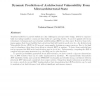Free Online Productivity Tools
i2Speak
i2Symbol
i2OCR
iTex2Img
iWeb2Print
iWeb2Shot
i2Type
iPdf2Split
iPdf2Merge
i2Bopomofo
i2Arabic
i2Style
i2Image
i2PDF
iLatex2Rtf
Sci2ools
ISCA
2007
IEEE
2007
IEEE
Dynamic prediction of architectural vulnerability from microarchitectural state
Transient faults due to particle strikes are a key challenge in microprocessor design. Driven by exponentially increasing transistor counts, per-chip faults are a growing burden. To protect against soft errors, redundancy techniques such as redundant multithreading (RMT) are often used. However, these techniques assume that the probability that a structural fault will result in a soft error (i.e., the Architectural Vulnerability Factor (AVF)) is 100 percent, unnecessarily draining processor resources. Due to the high cost of redundancy, there have been efforts to throttle RMT at runtime. To date, these methods have not incorporated an AVF model and therefore tend to be ad hoc. Unfortunately, computing the AVF of complex microprocessor structures (e.g., the ISQ) can be quite involved. To provide probabilistic guarantees about fault tolerance, we have created a rigorous characterization of AVF behavior that can be easily implemented in hardware. We experimentally demonstrate AVF variab...
Related Content
| Added | 03 Jun 2010 |
| Updated | 03 Jun 2010 |
| Type | Conference |
| Year | 2007 |
| Where | ISCA |
| Authors | Kristen R. Walcott, Greg Humphreys, Sudhanva Gurumurthi |
Comments (0)

